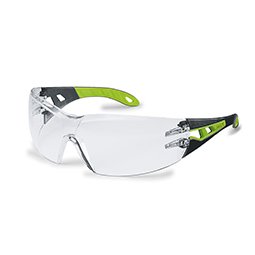Unflinching assault on eye-injury challenge
The Wates Group hoped that eye injuries would be a thing of the past after it introduced a mandatory eye protection policy that required everyone to carry eyewear and use it when work conditions demanded. In the five years that followed, 73 workers on Wates sites suffered eye injuries despite the policy, making it clear that just supplying the equipment was not enough.
The Wates Group hoped that eye injuries would be a thing of the past after they introduced a mandatory eye protection policy that required everyone to carry eyewear and use it when work conditions demanded. In the five years that followed, 73 workers on Wates sites suffered eye injuries despite the policy, making it clear that just supplying the equipment was not enough.
Eye injury is not just a problem for Wates, but remains a serious issue in construction generally. However, the Wates Group were focused on a zero eye injury target and knew that getting workers to understand the risks and wear the correct eye protection at all times would require a change of policy, an educational campaign to make the risks evident to everyone, and the introduction of equipment that workers would be happy to wear.
Most of the Wates injuries were minor, such as a moderate direct impact to the eye or eye area, or airborne foreign objects entering the eye. Some were more serious and classed as three day injuries, but none involved long-term loss or damage to eyesight.
The eye injury campaign was being driven by Sean Dillow, health and safety manager for the company’s retail division, but would affect almost 5,000 staff and contracted workers across all Wates sites in the UK. ‘Our accident figures weren’t worse than anyone else’s in the industry, but vision is the most important sense that we have and we wanted to cut this type of injury or eliminate it altogether,’ he said.
uvex was not a PPE supplier to Wates at that time and known only to Sean as a sports equipment brand of high quality ski and cycle goggles and helmets. When he learned of the company’s reputation in safety equipment too, uvex representatives were invited to work with Sean, developing the right educational message and an optimal range of eye protection products for the various tasks common to construction. Wates was moving towards a policy of mandatory eye protection onsite at all times rather than just carrying it, and knew that education rather than enforcement was central to the culture change required to make the new policy acceptable.
uvex and the Wates health and safety team worked together giving toolbox talks and supplying information on eye safety and the correct use and care of equipment. Eye injuries can be horrific, and the shock of this graphic reality was also important to dislodge the macho and fatalistic attitudes sometimes found in the industry.
Since the introduction in 2005 of the mandatory wearing of eyewear on site at all times, eye-injuries have fallen at Wates by more than 80%. Most of the injuries that did occur resulted from eye-protection not being worn at all, or from incorrect eyewear being selected for the job.
Many workers had been in the industry for decades and never worn eye protection or suffered injury, and for many the concept of eye protection equipment was something that was uncomfortable, unattractive and impeded vision. uvex had the task of presenting its modern coated lenses and frame designs and challenging workers to test the comfort and style of ranges which have received unparalleled wearer acceptance in construction and other industries.
Although infringements of the new ‘wear at all times’ policy are very visible and therefore easy to challenge, it was the cultural change that won support and made the policy work rather than the enforcement of an unpopular mandate on a reluctant workforce. The companies continue to work together even today, and the collaboration showed the value of companies working with their suppliers to achieve a common goal. Both organisations have a history of customer/supplier collaboration, and Wates had previously run a similar campaign against injuries to the hand after an analysis of minor injuries showed that 40% in this category were hand injuries. Trials run in conjunction with a glove supplier led to a new policy that required appropriate gloves to be worn onsite. The 2002 policy worked well and within two years hand injuries had reduced in real terms by 57% and compliance with the mandate remained high at 90%.
Although pleased with these outcomes, Wates’ ambition in health and safety runs beyond impressive reductions in accident statistics and last year the company announced a target of zero injuries by 2010. Building on successes to date, Wates believes that this is achievable even from an industry which accounts for more than 50 workplace deaths every year. A 30% improvement in accident figures in 2006 was an impressive start but still a long way short of zero injuries. The step-change in safety performance required to meet this goal will rely heavily on maintaining shifts in behaviour and attitude which brought this improvement, and extending this best practice across the whole group.
One company division is the Wates Living Space London and South group, which was responding to a poor safety result in 2005 when it transformed its performance the following year. Its comprehensive safety programme in 2006 engaged employees, suppliers and customers and stepped up training to three full days a year for every employee. The group also made safety the responsibility of all functions, not just site management, and communicated its safety performance across the organisation.

Useful links
Back to case studies
Press releases
Safety in sports
Contact us
